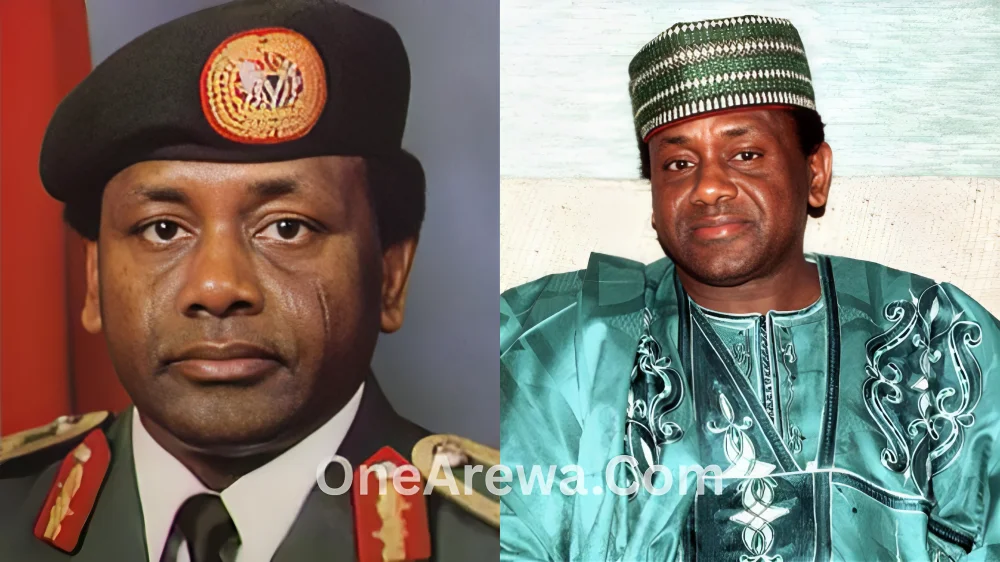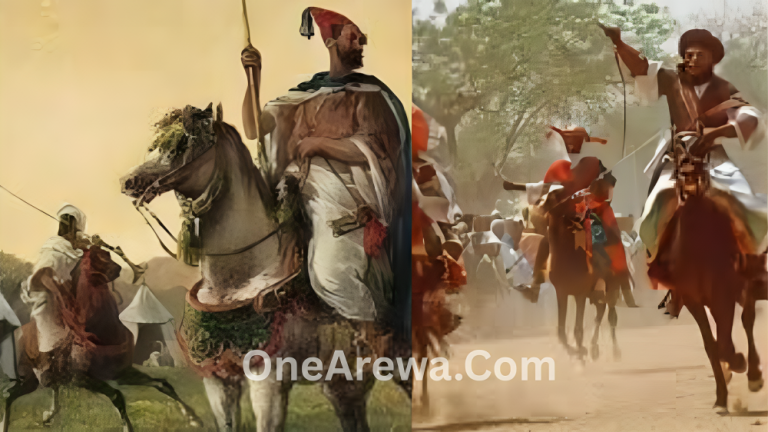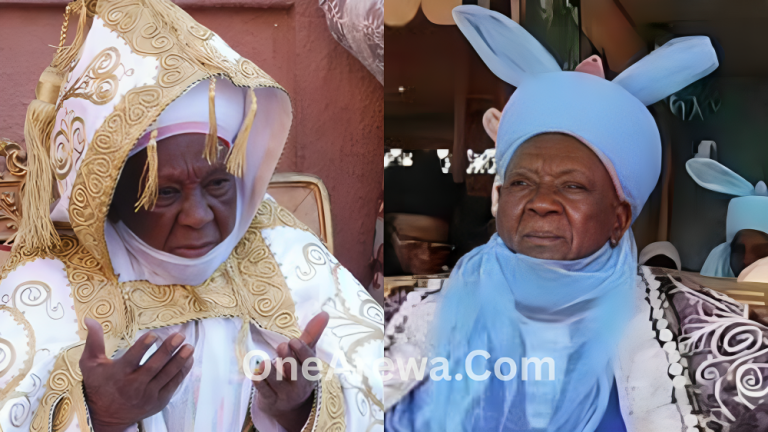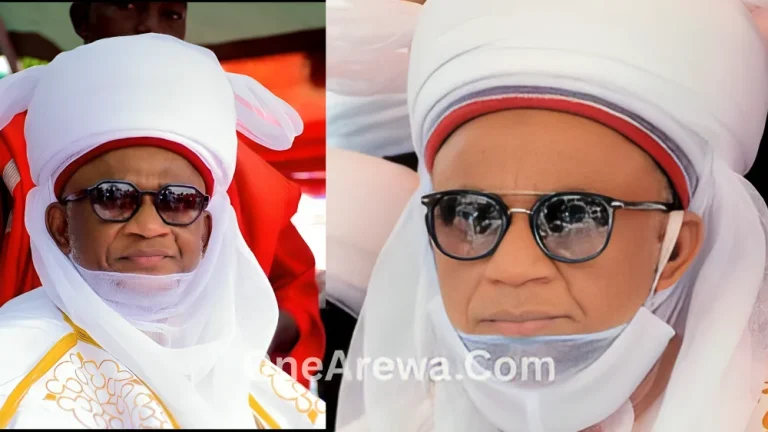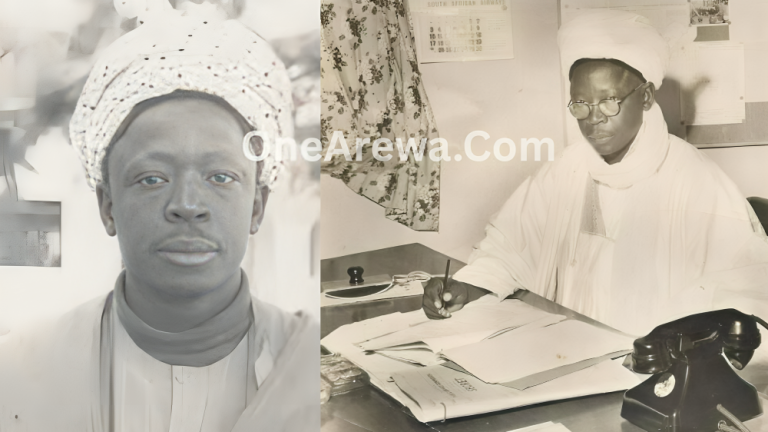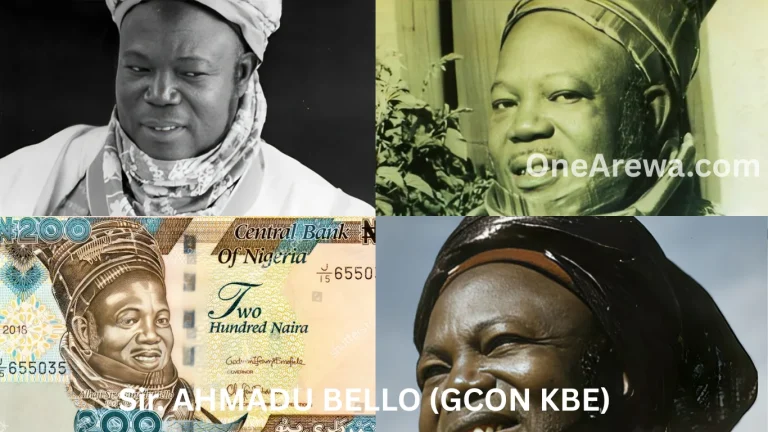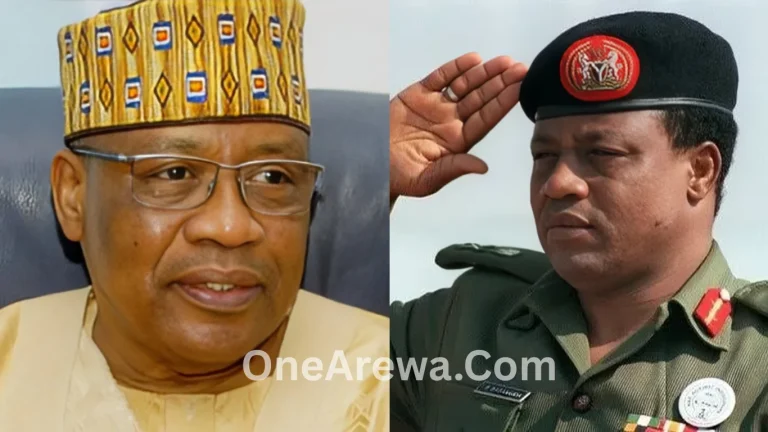General Sani Abacha: Nigeria’s Military Head of State (1993–1998) – Biography, Legacy and Controversies
General Sani Abacha: Nigeria’s Military Head of State (1993–1998) – Biography, Legacy and Controversies
General Sani Abacha GCFR (20 September 1943 – 8 June 1998) was a Nigerian military ruler and statesman who led Nigeria with an authoritarian grip from 1993 until he died in 1998, following a bloodless palace coup.
His regime is remembered for its harsh repression, lack of democratic freedoms, and widespread corruption.
Abacha’s rise to power marked Nigeria’s last successful military coup.
During his rule, he imposed a climate of fear, marked by severe human rights violations, political repression, and the assassinations or executions of opposition figures.
The most internationally condemned act of his regime was the execution of environmental activist Ken Saro-Wiwa and other members of the Ogoni Nine, which turned Nigeria into a pariah state and drew sharp global criticism.
Widely regarded as one of the most corrupt dictators of the 20th century, Abacha was accused of embezzling an estimated $2–5 billion.
These funds were reportedly stashed in foreign banks across Switzerland, Liechtenstein, the UK, and the United States.
His name remains synonymous with kleptocracy, and efforts to recover his stolen wealth continue to this day.
Abacha died unexpectedly on 8 June 1998, which paved the way for Nigeria’s return to democracy under the leadership of General Abdulsalami Abubakar.
His death ultimately led to the birth of the Nigerian Fourth Republic in 1999.
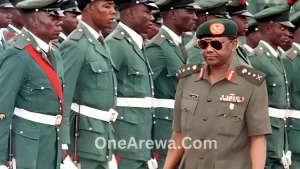
General Sani Abacha Biography
| Category | Details |
|---|---|
| Full Name | Sani Abacha |
| Title | General (GCFR) |
| Date of Birth | September 20, 1943 |
| Place of Birth | Kano, Northern Region, British Nigeria |
| Date of Death | June 8, 1998 |
| Place of Death | Aso Rock Presidential Villa, Abuja |
| Cause of Death | Officially heart attack (rumored poisoning) |
| Burial | Same day in Kano (Muslim tradition) |
| Spouse | Maryam Abacha |
| Children | 10 (7 sons, 3 daughters) |
| Grandchildren (2018) | 33 |
| Facial Marks | Tribal markings |
| Military Rank | General |
| Service Years | 1963–1998 |
| Key Wars Fought | Nigerian Civil War, First Liberian Civil War |
| Key Offices Held | Head of State, Minister of Defence, Chief of Army Staff, Chief of Defence Staff |
| Coup Participation | Involved in 1983 and 1985 coups |
| Came to Power | Overthrew Interim Government (1993) |
| Governance Style | Military dictatorship, anti-democratic |
| Key Oppression Acts | Execution of Ken Saro-Wiwa, imprisonment of Abiola & Obasanjo |
| Wealth Controversy | Estimated $3+ billion looted (recovery deals ongoing) |
| Achievements | Strengthened foreign reserves, infrastructure projects, ECOMOG support |
| End of Rule | Died in office; succeeded by Gen. Abdulsalami Abubakar |
| Legacy | Controversial: development vs dictatorship |
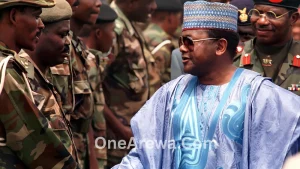
General Sani Abacha’s Early Life
General Sani Abacha was born and raised in Kano State, Nigeria, into a Kanuri family that originally hailed from what is now Borno State.
He began his military journey at the Nigerian Military Training College in Kaduna, a key institution for grooming future military leaders.
In pursuit of advanced military training, Abacha proceeded to Mons Officer Cadet School in Aldershot, England, and upon completion, he was officially commissioned into the Nigerian Army in 1963.
Check Out: General Ibrahim Badamasi Babangida: Nigeria’s Military Leader and Head of State (1985–1993)
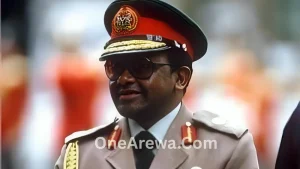
General Sani Abacha’s Military Career and Rise Through the Ranks
Throughout his military career, General Sani Abacha played a critical role in almost every major coup in Nigeria from the mid-1960s onward.
In July 1966, as a Second Lieutenant with the 3rd Battalion in Kaduna, Abacha actively participated in the Nigerian counter-coup, even being involved from the early planning stages.
There is speculation that he may have also been involved in the January 1966 coup during its Lagos or Abeokuta phases.
During the Nigerian Civil War (1967–1970), he served valiantly as a platoon and battalion commander, gaining vital combat and leadership experience.
In 1975, Abacha was appointed Commander of the 2nd Infantry Division, solidifying his growing influence within the military hierarchy.
By 1983, he had become the General Officer Commanding (GOC) of the 2nd Mechanised Division and was appointed to the Supreme Military Council, the ruling body of Nigeria’s military regime.
Abacha played a key role in two major coups:
In December 1983, he helped execute the coup that brought General Muhammadu Buhari to power.
In August 1985, he was instrumental in overthrowing Buhari and installing General Ibrahim Babangida as head of state.
Under Babangida’s leadership, Abacha was appointed Chief of Army Staff in 1985.
He became Minister of Defence in 1990.
He also served as Chief of Defence Staff from 1990 to 1993.
Abacha holds the distinction of being the first Nigerian Army officer to rise through every rank without skipping, a rare achievement in Nigeria’s military history.
General Sani Abacha Seizure of Power: The 1993 Nigerian Coup d’État
During the political crisis of the Third Republic, Sani Abacha, then Nigeria’s Minister of Defence and the most senior military officer, seized control of the government.
On November 17, 1993, he orchestrated a bloodless coup that overthrew the Interim National Government led by Ernest Shonekan.
In a national broadcast, Abacha framed the takeover as a necessary step to restore political stability and address the uncertainties triggered by the annulled 1993 presidential elections.

Military Rule: Sani Abacha as Nigeria’s Head of State (1993–1998)
Following the coup, General Sani Abacha declared himself Head of State and Commander-in-Chief of the Armed Forces.
He ruled Nigeria from 1993 until his death in 1998, consolidating absolute power shortly after assuming office.
In September 1994, he issued a decree placing his government above the jurisdiction of any court, effectively nullifying judicial independence.
Additional decrees empowered him to detain individuals for up to three months without trial, and he abolished Decree 691 of 1993, further tightening his grip on power.
Regime Maintenance and Human Rights Abuses:
General Sani Abacha built a strong internal security system, including a 3,000-man elite force trained in North Korea.
His Chief Security Officer, Hamza al-Mustapha, exercised overwhelming control over the country’s security apparatus.
The police were overhauled and retrained, while Abacha’s regime took a hard stance against crime and dissent.
Pro-democracy activists, including members of the National Democratic Coalition (NADECO), were accused of orchestrating bombings, and many were arrested.
Prominent figures like Moshood Abiola, who declared himself the rightful president, were jailed for treason; Abiola later died in custody.
Former President Olusegun Obasanjo and General Oladipo Diya were also arrested for alleged coup plots. Another military figure, General Shehu Musa Yar’Adua, died in prison in 1997.
The execution of environmental activist Ken Saro-Wiwa and eight other Ogoni leaders in 1995, due to their opposition to oil exploitation by Royal Dutch Shell, sparked international outrage.
Nigeria was suspended from the Commonwealth of Nations, and Nobel Laureate Wole Soyinka was charged with treason in absentia.
Abacha’s regime was widely condemned for human rights violations.
Economic Policies and National Development:
Despite his authoritarian rule, Abacha’s administration made significant economic strides:
Foreign reserves grew from $494 million in 1993 to $9.6 billion by 1997.
External debt dropped from $36 billion to $27 billion in the same period.
Inflation, which stood at 54%, was reduced to 8.5% by 1998.
Nigeria achieved this despite oil prices averaging only $15 per barrel.
Urban infrastructure improved, with 25 to 100 kilometers of road networks constructed in cities like Lagos, Kano, Kaduna, Enugu, Benin, Aba, Gusau, Zaria, and Port Harcourt.
However, privatization programs initiated under Ibrahim Babangida were suspended. Though GDP growth improved slightly, it remained heavily dependent on the petroleum sector.
The Abacha Loot: Unprecedented Embezzlement of State Funds:
Alongside his economic accomplishments, General Sani Abacha is infamous for orchestrating one of the largest corruption scandals in African history, popularly called the Abacha Loot.
Through fake national security funding requests, Abacha, working closely with National Security Adviser Ismaila Gwarzo, his son Mohammed Abacha, and close ally Alhaji Mohammed M. Sada, siphoned billions of dollars.
The Central Bank of Nigeria routinely delivered cash or traveller’s cheques to Gwarzo, who transported them to Abacha’s residence. The funds were then laundered into offshore accounts.
An estimated $1.4 billion was misappropriated through this channel alone.
In 2004, General Sani Abacha ranked fourth on a global list of the most self-enriching leaders, accused of looting between $1 billion and $5 billion. Reports in 2002 suggested his family agreed to return $1.2 billion.
The Obasanjo administration was accused of politicizing the recovery of the loot.
On August 7, 2014, the U.S. Department of Justice announced a $480 million forfeiture, the largest ever in its history, returning the funds to Nigeria.
In 2019, authorities in Jersey, the U.S., and Nigeria concluded asset recovery efforts, dividing $267 million in recovered funds, with continued repatriation efforts still ongoing.
National Politics Under General Sani Abacha:
During his rule as Nigeria’s military Head of State from 1993 to 1998, General Sani Abacha implemented major political reforms that continue to shape the country’s governance structure today.
One of his most notable contributions was the restructuring of Nigeria into six geopolitical zones, a move aimed at addressing the nation’s diverse ethnic, economic, and political realities.
Creation of Geopolitical Zones:
To promote regional balance and administrative efficiency, General Sani Abacha reorganized the country by grouping its states into the following six geopolitical zones:
-
North Central: Benue, Kogi, Kwara, Nasarawa, Niger, Plateau, and the Federal Capital Territory (FCT).
-
North East: Adamawa, Bauchi, Borno, Gombe, Taraba, and Yobe.
-
North West: Jigawa, Kaduna, Kano, Katsina, Kebbi, Sokoto, and Zamfara.
-
South East: Abia, Anambra, Ebonyi, Enugu, and Imo.
-
South South: Akwa Ibom, Bayelsa, Cross River, Delta, Edo, and Rivers.
-
South West: Ekiti, Lagos, Ogun, Ondo, Osun, and Oyo.
This reorganization was made possible after six new states were created, increasing the number from 30 to 36 states in total.
Constitutional Conference and Failed Transition to Civilian Rule:
Between 1993 and 1995, General Sani Abacha convened a constitutional conference aimed at laying the groundwork for a return to civilian rule. However, his intentions became questionable as the transition process progressed.
In early 1998, General Sani Abacha announced plans to hold national elections on August 1, to hand over power to a civilian government by October 1, 1998.
However, by April 1998, it became evident that the transition was a façade; all five officially registered political parties were coerced into endorsing Abacha as the sole presidential candidate, effectively eliminating any democratic competition.
Foreign Policy During Abacha’s Regime:
General Sani Abacha’s foreign policy was controversial and often strained Nigeria’s international relationships, particularly with Western democracies.
His regime was marked by human rights abuses, authoritarianism, and defiance of global diplomatic norms.
Ken Saro-Wiwa’s Execution and International Backlash (1995):
In 1995, General Sani Abacha’s government executed Ken Saro-Wiwa, a renowned environmental activist and writer, along with eight other Ogoni leaders.
The executions followed a secret military tribunal and drew widespread international condemnation.
Notably, Nigeria was suspended from the Commonwealth of Nations in the aftermath of the executions.
Although Abacha had reportedly promised Nelson Mandela that he would consider commuting the death sentences, he ultimately did not intervene.
The presiding judge, Justice Ibrahim Auta, sentenced Saro-Wiwa to death by hanging, a sentence that was swiftly carried out despite global appeals for clemency.
Gaddafi Visit and Violation of UN Sanctions (1997):
In 1997, Libyan leader Muammar Gaddafi visited Nigeria during a tour to celebrate the Islamic New Year, directly violating United Nations sanctions on Libya.
Abacha welcomed Gaddafi with full honors, and thousands of Nigerians in Kano came out in support.
This move aligned with Gaddafi’s broader Pan-Africanist agenda, signaling Abacha’s willingness to defy Western influence in Africa.
Intervention in the Liberian Civil War:
General Sani Abacha also took an active role in regional stability efforts. As part of the Economic Community of West African States Monitoring Group (ECOMOG), Nigeria deployed troops to Liberia during the country’s civil war.
This intervention began in 1990, when Abacha served as Defence Minister, and continued throughout his presidency.
Controversial Ties with U.S. Political Figures:
Despite condemnation by the U.S. State Department, Abacha maintained unexpected links with several American political figures.
In 1997, Senator James Inhofe (R-Oklahoma) visited Nigeria as a member of a Christian evangelical group known as “The Family.” From that point, Abacha fostered a working relationship with the group.
Other notable American figures who engaged with his regime included Senator Carol Moseley Braun (D-Illinois), Reverend Jesse Jackson, and Minister Louis Farrakhan
Many African-American leaders visited Nigeria during this period, with some expressing support for Abacha’s administration, despite his human rights record.
NOTE: General Sani Abacha’s era remains one of the most controversial periods in Nigeria’s political history.
His domestic restructuring has had lasting effects, but his autocratic leadership, international defiance, and suppression of political opposition continue to attract scrutiny.
Understanding the context and events of his regime is crucial to appreciating the complexities of Nigeria’s modern governance and international relations.
Check Out: Sir Abubakar Tafawa Balewa: Nigeria’s First Prime Minister (1912-1966)

General Sani Abacha Personal Life
General Sani Abacha was married to Maryam Abacha, and together they had ten children, seven sons and three daughters.
As of 2018, the General Sani Abacha family had reportedly grown to include thirty-three grandchildren.
Notably, the distinctive scars on Abacha’s face were traditional tribal markings, a common cultural practice among certain ethnic groups in Nigeria.
General Sani Abacha’s Death – June 8, 1998
On the morning of Monday, June 8, 1998, General Sani Abacha died suddenly at the Aso Rock Presidential Villa in Abuja, Nigeria’s seat of power.
In keeping with Islamic burial customs, he was buried the same day without an autopsy.
This quick burial led to widespread speculation and conspiracy theories, with many suspecting assassination rather than natural causes.
The official cause of death was announced as a sudden heart attack.
However, several foreign diplomats and U.S. intelligence analysts speculated that he may have been poisoned, possibly while in the company of prostitutes.
Further fueling the theory, Hamza al-Mustapha, Abacha’s former chief security officer, claimed that Israeli operatives may have been involved, allegedly under the cover of a meeting with Yasser Arafat.
At the time of his death, Abacha was said to be preparing to transition power to a civilian government by October 1998, a move initially proposed in 1995.
Following his death, General Abdulsalami Abubakar succeeded him as Head of State, and his brief regime played a pivotal role in birthing the Fourth Republic of Nigeria.
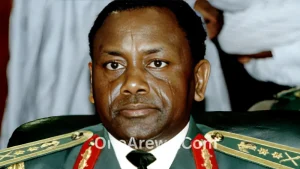
General Sani Abacha Trivia
1. First Nigerian Soldier to Reach Full General Without Combat: Abacha was the first Nigerian Army officer to rise from Second Lieutenant to full General without skipping a single rank, and without engaging in any international combat.
2. Shortest Transition From Coup to Presidency: In 1993, Abacha overthrew the Interim National Government led by Ernest Shonekan, just 83 days after it was formed, the shortest-lived government in Nigeria’s history.
3. Died Under Mysterious Circumstances: Abacha died suddenly on June 8, 1998, in the Aso Rock Presidential Villa, officially of a heart attack, but many believe he was poisoned.
4. Massive Loot Linked to His Family: Over $3 billion was allegedly looted by Abacha and his family. The term “Abacha loot” became globally recognized, and many countries have returned stolen funds.
5. Declared Five Political Parties as “The Five Fingers of a Leprous Hand”: He was accused of trying to manipulate democracy by sponsoring all five political parties during his regime, all of which endorsed him as their sole presidential candidate.
6. Had Tribal Marks on His Face: Abacha’s distinctive facial scars were Fulani tribal markings, common among northern Nigerian communities.
7. Banned All Political Activities: Immediately after taking power, he banned all political activities, dissolved democratic institutions, and established a military dictatorship.
8. The Most Feared Nigerian Leader of the 90s: Abacha’s era was marked by severe human rights abuses, especially the execution of Ken Saro-Wiwa and eight other Ogoni activists, which triggered international outrage.
9. Oversaw ECOMOG Missions: Despite his authoritarianism, Abacha committed troops to peacekeeping missions in Liberia and Sierra Leone, helping stabilize the West African region.
10. Buried Without Autopsy: He was buried within hours of his death under Islamic tradition, without an autopsy, adding fuel to assassination rumors.
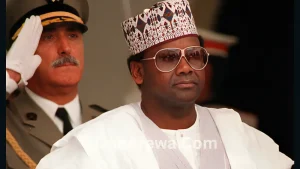
General Sani Abacha’s legacy
General Sani Abacha (1993–1998) ruled Nigeria as a military dictator, leaving behind a deeply controversial legacy.
He is remembered for his authoritarian rule, during which he banned political opposition, jailed and executed critics, and ruled through fear.
His regime was notorious for massive corruption, with billions of dollars looted and stashed in foreign banks, some of which have been recovered.
On the economic front, he is credited with stabilizing Nigeria’s economy, controlling inflation, and increasing foreign reserves, though critics argue this came at the expense of transparency and freedom.
He also boosted Nigeria’s military influence in West Africa, especially through peacekeeping missions.
Despite promises of democracy, he tried to install himself as a civilian president, discrediting the democratic process.
Abacha’s legacy remains divisive; some view him as a strong, disciplined leader, while others see him as one of Nigeria’s most brutal and corrupt rulers.
Check Out: Mallam Aminu Kano (1920–1983): Biography, Legacy, Political Influence, and Lessons from His Life
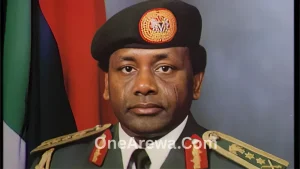
General Sani Abacha’s Military Career – Dates of Rank
Here is a summary of General Sani Abacha’s progression through the Nigerian military ranks:
| Year | Rank Achieved |
|---|---|
| 1963 | Second Lieutenant (Commissioned) |
| 1966 | Lieutenant |
| 1967 | Captain |
| 1969 | Major |
| 1972 | Lieutenant Colonel |
| 1975 | Colonel |
| 1980 | Brigadier General |
| 1984 | Major General |
|
1987 |
Lieutenant General |
| October 1990 | General |
FAQs
1: Who Was General Sani Abacha?
General Sani Abacha (born September 20, 1943, in Kano, Nigeria – died June 8, 1998, in Abuja) was a Nigerian military general and politician who ruled Nigeria as its head of state from 1993 until he died in 1998.
He is one of the most controversial figures in Nigerian history, known for his authoritarian rule, widespread corruption, and repressive tactics.
2: When and where was Sani Abacha born?
He was born on September 20, 1943, in Kano, located in present-day northern Nigeria.
3: What were Sani Abacha’s major military ranks before becoming head of state?
-
1963: Second Lieutenant
-
1966: Lieutenant
-
1967: Captain
-
1969: Major
-
1972: Lieutenant Colonel
-
1975: Colonel
-
1980: Brigadier General
-
1984: Major General
-
1987: Lieutenant General
-
1990: Full General
4: How did Abacha come to power in 1993?
After the annulment of the June 12, 1993, presidential election by then-military ruler Ibrahim Babangida and the installation of an interim civilian government led by Ernest Shonekan, Abacha staged a bloodless coup on November 17, 1993, and assumed full control as Head of State.
5: What were the hallmarks of his rule?
-
Repression of political opponents
-
Suppression of the press and freedom of speech
-
Massive corruption and looting of public funds
-
Establishment of a vast security apparatus
-
Execution of activists, including Ken Saro-Wiwa
-
Peacekeeping efforts in West Africa (Liberia, Sierra Leone)
6: Why is Sani Abacha considered controversial?
His government was accused of gross human rights violations, jailing political opponents like MKO Abiola and Olusegun Obasanjo, and executing environmental activists.
After his death, investigations revealed he embezzled billions of dollars, making him a symbol of kleptocracy in Africa.
7: What was the cause of Abacha’s death?
Official reports claimed a sudden heart attack on June 8, 1998, at the Aso Rock Presidential Villa, Abuja.
However, rumors persist that he may have been poisoned, possibly while in the company of foreign escorts.
8: What happened after Abacha’s death?
General Abdulsalami Abubakar succeeded him and initiated a transition to democracy. By 1999, Nigeria returned to civilian rule with the election of Olusegun Obasanjo.
9: How much did Abacha allegedly steal from Nigeria?
Estimates suggest that the Abacha family looted between $3 billion and $5 billion.
These funds were stashed in foreign accounts, and much of it has been recovered and repatriated over the years.
10: What is the legacy of General Sani Abacha?
His legacy is deeply divisive. Some praise his economic policies (such as stabilizing the naira and foreign reserves), while many others view him as a symbol of tyranny, repression, and corruption.
His rule is a cautionary tale in Nigerian political history.
11: Was there any effort to return Nigeria to civilian rule during Abacha’s reign?
While Abacha promised a democratic transition, he manipulated political processes and planned to transition to a civilian president himself in 1998, having all five registered parties nominate him as their sole candidate.
12: Who were some of the high-profile individuals jailed by Abacha?
-
MKO Abiola – Winner of the 1993 annulled election
-
Olusegun Obasanjo – Former military ruler
-
Shehu Musa Yar’Adua – Prominent politician (died in jail)
-
Wole Soyinka – Nobel laureate, charged with treason in absentia
Check Out: Abubakar Imam (1911–1981): Northern Nigeria’s Pioneer Intellectual and Political Icon
In Conclusion
General Sani Abacha remains one of the most controversial figures in Nigeria’s history.
As the country’s military Head of State from 1993 to 1998, he ruled with absolute authority, silencing opposition and curtailing democratic freedoms.
While his regime achieved some macroeconomic stability and foreign reserve growth, it was heavily overshadowed by severe human rights abuses, the execution of activists like Ken Saro-Wiwa, and widespread allegations of corruption, most notably the looting of billions of dollars.
His sudden death in 1998 marked a turning point that led to Nigeria’s return to civilian rule under General Abdulsalami Abubakar and later Olusegun Obasanjo.
To this day, Abacha’s legacy evokes strong reactions, both for the firm control he maintained and the dark cloud of authoritarianism and kleptocracy that defined his era.
Check Out: General Yakubu Gowon: Nigeria’s Youngest Head of State and Civil War Leader (1966–1975)
Check Out: General Murtala Ramat Muhammed: Nigeria’s Boldest Head of State (1975–1976)
